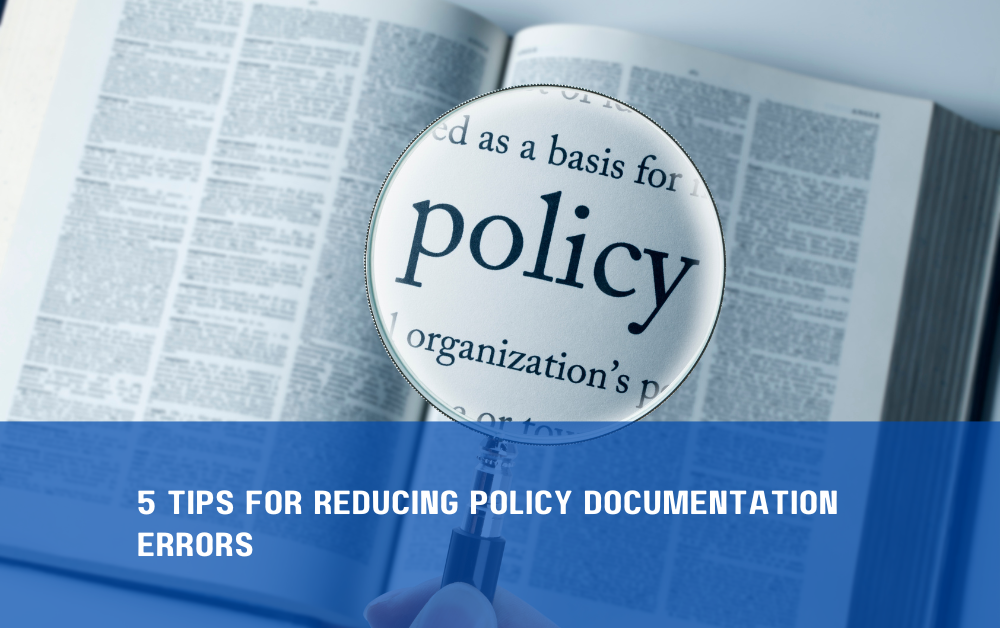Accuracy in policy documentation goes far beyond administrative tasks—it’s at the heart of compliance, customer satisfaction, and brand reputation. A single misprint or omission can lead to coverage disputes, regulatory fines, and a loss of trust among clients.
Fortunately, insurers can implement straightforward yet powerful strategies to drastically reduce errors and build a more reliable documentation process. Below are five tips to help you achieve top-notch accuracy in policy documentation.
1. Standardize Your Templates and Forms
Why Standardization Matters
In a rapidly evolving insurance landscape, policy language, regulatory clauses, and product details can change frequently. Relying on multiple, inconsistent templates across teams and departments is a recipe for errors—and a nightmare for compliance.
How to Do It
- Create a Central Repository: Host all templates in a single, controlled system (e.g., a low-code platform like OutSystems). Ensure each department accesses the same updated version.
- Define Naming Conventions: Label each document clearly (e.g., form type, version number, effective date). This makes it easy to search, retrieve, and verify the correct version.
- Automate Version Control: Use technology to track changes and maintain a comprehensive audit trail. This way, you can revert to previous versions if needed.
Real-World Impact: A mid-sized insurer that consolidated over a dozen policy templates into one standardized format reduced documentation errors by 30% within the first six months.
2. Leverage Role-Based Access and Approval Workflows
Why Access Matters
Not everyone in the organization needs to edit a policy document. By restricting document editing and approvals to the correct roles, you minimize the risk of unintentional or unauthorized changes.
How to Do It
- Map Responsibilities: Identify which teams handle underwriting, legal, compliance, and final approvals. Assign them granular permissions.
- Automate Approval Steps: Implement a workflow where each update triggers an alert to the next stakeholder—e.g., compliance only reviews specific clauses, while underwriters confirm coverage details.
- Audit and Reporting: A clear audit trail records who made changes and when, enabling quick issue resolution and strong internal controls.
Real-World Impact: By introducing role-based workflows, a commercial lines insurer eliminated 50% of back-and-forth emails for policy documentation edits, significantly reducing human error.
3. Integrate Data Sources for Real-Time Accuracy
Why Integration Matters
Disconnected systems (policy administration, billing, CRM) invite manual data re-entry, which inevitably leads to typos and inconsistencies. Instead, tap into real-time data flows that update policy documents automatically.
How to Do It
- Use APIs for Data Exchange: Connect your policy documentation module to core systems via REST or SOAP APIs so that any change—like a new address or coverage limit—automatically updates the relevant forms.
- Pre-populate Fields: Eliminate repetitive data entry by auto-filling policyholder information from existing databases.
- Validation Checks: Set up rules that flag potential errors (e.g., expired zip codes or invalid coverage limits) before finalizing the document.
Real-World Impact: An insurer integrated its billing and policy systems, reducing data re-entry points by 60%. This not only streamlined workflow but led to a sharp decline in policy issuance errors.
4. Embed Automated Quality Checks
Why Quality Checks Matter
Even with standardized templates and data integration, mistakes can slip through if there’s no final safety net. Automated quality checks serve as an additional layer of protection and verification.
How to Do It
- Rule-Based Validation: Configure validations for common error points—like coverage amounts that exceed underwriting guidelines or missing endorsements for particular lines of business.
- Text Consistency Tools: Deploy keyword checks to ensure vital clauses or disclaimers aren’t accidentally removed or altered.
- Redlining and Comparison Features: An automated compare function highlights changes between document versions, making it easy to spot unexpected modifications.
Real-World Impact: After implementing a series of automated validations in OutSystems, one life insurance provider detected 90% of potential errors during pre-submission checks, saving countless hours of rework.
5. Provide Ongoing Training and Feedback Loops
Why Training Matters
Technology alone can’t guarantee error-free documentation. The human element—underwriters, agents, compliance officers—must understand how to use new systems and workflows effectively.
How to Do It
- Frequent Workshops: Conduct regular sessions to familiarize teams with the latest templates, approval workflows, and validation rules.
- Centralize Knowledge Base: Maintain up-to-date guides and FAQs so staff can quickly reference best practices.
- Leverage Analytics: Track common error types or areas. Then focus training on those pain points, ensuring continuous improvement.
Real-World Impact: A property & casualty insurer that combined automated checks with regular staff training reduced its policy documentation error rates by 40% within the first year.
Bringing It All Together: The Power of Low-Code
While each of these five tips can stand alone to reduce documentation errors, integrating them under a low-code platform like OutSystems can provide exponential benefits. Low-code solutions simplify data integration, enable visual workflows, and streamline the development of automated checks—all while offering scalability and flexibility as your business evolves.
Key Takeaways
- Centralize and Standardize: One template, one repository, multiple lines of defense against errors.
- Control Access and Workflows: Ensure only authorized edits, with transparent approvals.
- Automate Data Flow and Validation: Eradicate manual re-entry and maintain real-time accuracy.
- Invest in Training: Systems are only as effective as the people using them.
Conclusion: Your Roadmap to Error-Free Documentation
Reducing policy documentation errors is a multi-pronged effort: it combines rigorous workflows, smart integration, automated checks, and well-trained staff. Implementing these five tips lays a solid foundation for insurers to boost compliance, save costs, and enhance customer satisfaction.
At the end of the day, every accurate policy document is a testament to your organization’s commitment to excellence—helping retain existing customers and attract new ones.
Ready to Revolutionize Your Documentation Process?
At RST, we specialize in building and customizing low-code OutSystems solutions that streamline form management, enhance workflow automation, and minimize errors.
Contact us today to explore how we can help your insurance operations achieve peak efficiency and accuracy. Together, we’ll craft a documentation process that stands strong against errors—and stands out from the competition.







